Technologies / Agro-Technique Development for Kymore Plateau of Central India
1. Eucalyptus based Agri-silviculture System
| Sl No. |
Items |
Details |
| 1 |
Specification and salient technical features (principles for successful adoption, suitability/ recommendation of technology to different agro-climatic conditions, how it is an improvement over the existing technology or know-how, eco-friendliness to the environment of the factors incorporated in the technology etc.) |
Eucalyptus is very popular in MP especially in Kymore plateau and planted by farmers in good and poor soil. It is planted in field bund and culturable wasteland. It can be grown in un-irrigated as well as irrigated condition. In commercial plantation drip irrigation provided by the farmers for saving of water and higher tonnage in short time. Growing of crop like paddy, wheat, arhar with Eucalyptus helps in conservation of soil and water because as it work as shelterbelts, protection of sol, supply of timber, fuel wood as pole and raw material for paper industries. |
| 2 |
Performance results (which respect to efficiency, sustainability etc.) |
Eucalyptus based agri-silviculture system where paddy, wheat, arhar grown (as intercrop) with Eucalyptus produce paddy 2500 kg ha-1, wheat 2500 kg ha-1 and arhar 1500 kg ha-1 (1st year)- 300 kg ha-1 (4th year) and eucalyptus tree @ Rs. 250-750 tree resulting higher net profit.
Besides this there has been reduction in weed population and regular inter culture of operation help in conservation of moisture. |
| 3 |
Likely cost (cost of intervention and output per unit area) |
Total cost of cultivation in Eucalyptus + paddy & wheat in 6 year vary from 10,000-15,000 Rs/ha/yr giving output in terms of net profit per unit area from Eucalyptus (planted in field bund 2m apart) + paddy + wheat was 82,000 ha-1yr-1.
When Eucalyptus planted in field 8 x 1.5 m (paired row) with arhar crop produce net profit per unit area was Rs. 1,26,000 ha-1yr-1 as compared to arable cropping i.e., Rs 53,000 ha-1yr-1 was obtained with paddy-wheat and Rs 34,500 ha-1yr-1 with arhar grown alone (with Eucalyptus). |
| 4 |
How the new technology will impact the income of the farmers and its benefits over conventional technologies/ know- how in terms of saving the cost of production, inputs, timeliness; and other pertinent information. |
Over all net income per hectare per year with Eucalyptus (planted in field bound 5m apart)+ paddy+ wheat raised from Rs 53,000 (paddy+ wheat alone) to Rs 82,000 ha-1yr-1 (Eucalyptus + paddy + wheat).
Similarly net income per hectare per year with Eucalyptus planted in fields 8 X 1.5 m (paired row) raised from Rs 34,500 ha-1 yr-1 to Rs 1, 26,000 ha-1yr-1. |
| 5 |
Social/environmental/other benefits |
Eucalyptus is tall, narrow canopy spread plant, hence it work as shelterbelt, protect the field crops from hot blowing wind result conservation of moisture, improvement in soil health, environment security, help in drain out excessive water in water logged soil. Besides Co2 sequestration and soil improvement, it increases organic matter and also increases bulk density and infiltration.
Farmers believe that Eucalyptus plantation reduced water table, but it is not true. It is shallow rotted tree hence no adverse effect on water table has been observed. This plant is very useful where soil is suffering due o water logging continuous saturation. Such ill drained soil can be reclaimed successfully with Eucalyptus based agri-siviculture system. |
| 6 |
Status of commercialization/ IP rights etc. |
This technology has already been reached to the farmer’s field through team of KVK Jabalpur, Umeria and adjoining part of Jabalpur. |
| 7 |
If commercialized, name and address of the farmer/ entrepreneur to whom the technology has been transferred. |
A large number of farmers used this technology in large scale Mr. Deepankar Agrawal village Majeda (Bheraghat, Jabalpur) planted Eucalyptus in 160acre and different kharif crop like paddy some medicinal plant like Buch and wheat crop in rabi season was taken.
Mr. R K Nema in new Bharaghat, Jabalpur planted Eucalyptus in 100 acre and taking crop.
Mr. Manesh Choubey, village Muskura planted Eucalyptus in 20 acre area and taking wheat, soyabean, mustard, gram, chilli etc. |
| 8 |
Any special requirement for its successful realization; any other standards etc. |
This technology is suitable for rainfed, poor land, undulating soil even in water logged soil. According to different situation, selection of suitable intercrop like paddy in water logged condition. In initial stages besides paddy, wheat, soyabean, mustard, chilli can be taken.
As the plant grows (3rd year on ward and produced shade) turmeric and oat (fodder) crop can be taken successfully. |
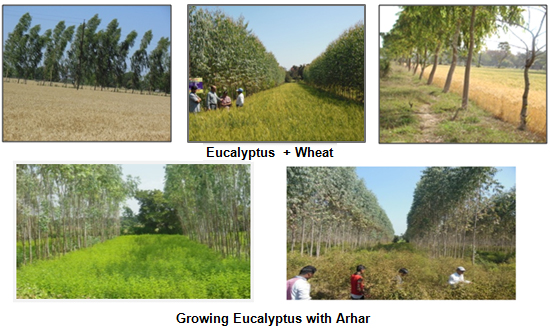
Guava based Agri-horticulture System
| Sl No. |
Items |
Details |
| 1 |
Specification and salient technical features (principles for successful adoption, suitability/ recommendation of technology to different agro-climatic conditions, how it is an improvement over the existing technology or know-how, eco-friendliness to the environment of the factors incorporated in the technology etc.) |
Guava is second most popular fruit tree of Madhya Pradesh. It can be grown successfully in variety of soil and climatic condition. Guava is generally cultivated by farmers as orchards or grown mostly on bund and in the field with different arable crops. Farmers and their family are generally suffered due to mal nutrition and fruits are the main sources of nutrition. In the state of Madhya Pradesh 60 % area under rainfed hence cultivation depends on rains and moisture conservation practices. The rainfall pattern is very erratic hence crops are generally adversely affected by weather condition, hence in arable cropping farmers not getting sufficient return for their livelihood. Introduction/ inclusion of fruit tree with arable cropping (agri-horticulture) can not only provide nutritional security but also assure employment and livelihood security besides conservation of soil and moisture. Under rainfed condition mustard can be grown successfully, hence mustard crop were introduced with guava. The plantation of Guava (variety L-49) with mustard crop can be continuousully grown for 3 years. |
| 2 |
Performance results (which respect to efficiency, sustainability etc.) |
Fruit based agri-horticulture system produce mustard yield vary from 240 to 424 kg ha-1 and fruit yield 2100 kg ha-1 to 3900 kg ha-1 resulting higher net profit.
Besides this, crop residue of crop and letter fall of fruit tree helps in increasing organic matter through decomposition along with conservation of moisture and improvement in physical condition of soil. |
| 3 |
Likely cost (cost of intervention and output per unit area) |
Total cost of cultivation in 14 year is approx 42,000 i.e., (3,000 ha-1yr-1), output in term of net profit per unit area is Rs 11,000 ha-1 yr-1 as compared to orchard alone (Rs 8,700 ha-1yr-1). In farmer’s field also agri-horticulture system (Guava + wheat) gave higher profit/ unit area (Rs 23,000 ha-1yr-1) as compared to wheat alone (19,000 ha-1yr-1). |
| 4 |
How the new technology will impact the income of the farmers and its benefits over conventional technologies/ know- how in terms of saving the cost of production, |
The overall net income per hectare per year with guava + mustard raised from Rs 8,700 ha-1yr-1 (guava alone) to Rs 11,000 ha-1yr-1 (guava + paddy) under partial irrigation condition.
Similarly for the net income per hectare per year with guava + wheat raised from Rs 19,000 ha-1 yr-1 crop alone i.e., farmers practices to Rs 23,000 ha-1yr-1 under agri-horticulture system. |
| 5 |
Social/environmental/other benefits |
Tree cover reduces the free flow of runoff; reduce velocity of runoff, water erosion, increase infiltration and help in water retention and conservation (storage) in the field/ soil. Organic residue of crops and tree also improves the physical condition of soil. |
| 6 |
Status of commercialization/ IP rights etc. |
This technology has been popularized through training, SMS and also through wasteland development programme. TSP programme through AICRP on Agroforestry also promotes the adoption and popularization of Agri-horticulture system. |
| 7 |
If commercialized, name and address of the farmer/ entrepreneur to whom the technology has been transferred. |
Technology has already been transfered to the farmers field through training by KVK’s, wasteland development project and TSP scheme under AICRP AF but not at commercial scale, Mr. Rajkumar Darpan, village Jodhpurtola (Tilwara) is taking different crop like gram, wheat with guava. Growing of wheat in guava orchards is prevalent in Sehora block were most of the farmers grown guava in their field. |
| 8 |
Any special requirement for its successful realization; any other standards etc. |
This technology is suitable under un irrigated, irrigated as well as in partial irrigated condition, poor land. The farmers are generally planted Guava in field bunds and in kitchen garden and taking number of crops like paddy, wheat, arhar, soyabean, even vegetables as intercrop. |
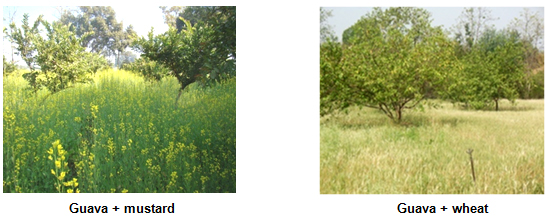
Aonla-Beal based horti-medicinal system in central India (Kymore plateau)
| Sl No. |
Items |
Details |
| 1 |
Specification and salient technical features (principles for successful adoption, suitability/ recommendation of technology to different agro-climatic conditions, how it is an improvement over the existing technology or know-how, eco-friendliness to the environment of the factors incorporated in the technology etc.) |
Aonla or Indian gooseberry (Emblica officinalis) and Beal (Aegle marmelos) are hardy in nature and suitable for growing in dry and wasteland area. Fruits are nutritive and having medicinal value. Aonla has sparse foliage whih allow 87.5 percent area for inter cropping during initial 10 years. As the plant grow, produced shade hence shade tolerant crops like turmeric can be grown successfully.
In dry area where most of cultivated fruit plant cannot performed well under such condition such wild fruits (Aonla & Beal) can grow successfully. The fruits are required less nutrient, low water requirement grow well under adverse condition. This soil having poor water holding capacity, shallow in depth gravel, undulation not suitable for agriculturable crops, wild fruit tree grow successfully with higher return. Hence in MP quite good amount of area under wasteland (11%). Thus these grey areas can be utilized for efficiently and economically by fruit based horti-medicinal system.
Turmeric crop was introduced in Aonla-Beal plantation this system helps in utilization of waste land, culturable wasteland, dry area, undulating, poor soil, shallow in depth and poor water holding capacity. At the time of establishment of orchard, recommended package of practices for cultivation of wild fruit tree was followed and plantation was made 5 x 5 m row to row spacing. No irrigation is required to crop during kharif but in rabi irrigation is required as & when water require. |
| 2 |
Performance results (which respect to efficiency, sustainability etc.) |
Wild fruit based horti- medicinal system (where fruit plant were planted 5 x 5 m) produced turmeric yield 8300-9400 kg ha-1, Aonla 8000 kg ha-1 and Bael 75-80 fruit /tree resulting higher net profit. Turmeric grown in ridge bed method higher yield (9300 kg ha-1) as compare to flat bed method (8500 kg ha-1) this system facilitate in conservation of soil (through checking soil erosion) and water (reduce runoff, increase percolation and conservation of soil moisture. |
| 3 |
Likely cost (cost of intervention and output per unit area) |
The average cost of cultivation in fruit tree is Rs. 2000- 3000 ha-1 and field crop Rs 70,000- 80,000 ha-1 output in term of net profit per unit area with Aonla + turmeric was Rs 84,000 ha-1yr-1 (at the age of 22 years). |
| 4 |
How the new technology will impact the income of the farmers and its benefits over conventional technologies/ know- how in terms of saving the cost of production, inputs, timeliness; and other pertinent information. |
The overall net income per hector per year with horti- medicinal system (i.e., Aonla + turmeric) is Rs 84000 ha-1 yr-1 and Rs 95,000 ha-1 yr-1(Beal + turmeric) as compare to growing of crop alone (turmeric) i.e., Rs 73000 ha-1 yr-1 (arable cropping farmer’s practices) under partial irrigated condition. |
| 5 |
Social/environmental/other benefits |
Aonla, Beal and turmeric reduces the impact of raindrop by covering the entire soil surface which reduce runoff velocity and protect the soil against soil erosion and improvement in infiltration/peculation of water in soil. Due to continuous fall of leaves add organic matter, improve physical condition of soil, and make soil healthy and productive. |
| 6 |
Status of commercialization/ IP rights etc. |
This technology has been popularized through training SMS of KVK, officers of Agriculture department through training organized in Agriculture institutes and Krishi Vigyan Kendra of JNKVV. |
| 7 |
If commercialized, name and address of the farmer/ entrepreneur to whom the technology has been transferred. |
Technology has been transfered to farmers field through KVK under various training programme, field visit and through TSP also Mr. Deepankar Agrawal village Majeda (Bheraghat, Jabalpur) grown turmeric with Aonla during year 2011-2012 in 7 acre. Mr. Manish Jha, village Seonitola taking wheat with Aonla in 3 acre area. |
| 8 |
Any special requirement for its successful realization; any other standards etc. |
As technology is based on utilization of degraded land by plantation of Aonla and tropical fruit tree. Farmers are taking other crop like wheat with Aonla under partial irrigation condition. |
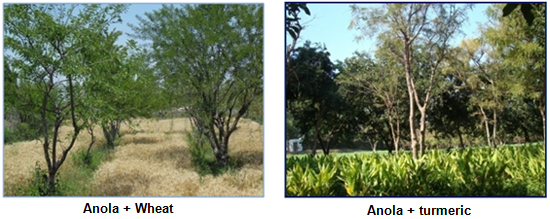
Dalbergia sissoo + paddy-wheat based Agri-silviculture System
| Sl No. |
Items |
Details |
| 1 |
Specification and salient technical features (principles for successful adoption, suitability/ recommendation of technology to different agro-climatic conditions, how it is an improvement over the existing technology or know-how, eco-friendliness to the environment of the factors incorporated in the technology etc.) |
D. sissoo is most suitable tree for agroforestry, having fast growth, clear bole and nitrogen fixing capacity besides providing protein rich fodder. This species is famous for aforestation/reforestation both in social forestry and in agroforestry. In State of Madhya Pradesh, there is a huge gap in between supply and demand of wood for fuel and timber D. sissoo can be grow successfully in variety of soils (light, medium, heavy, poor, shallow even in water logged) and climatic condition. In MP soil are vary from clay loam to clay, medium to heavy in nature, cracking when dry, good water holding capacity but poor drained. D. sissoo can be grown successfully in this soil. Jabalpur is situated in Kymore plateau broadly known rice-wheat crop zone of MP. Rice and wheat are the major crop hence, this area is most suitable for D. sissoo +paddy- wheat based agri-silviculture system. This system facilitate in improvement in soil fertility through nitrogen fixation, addition of nutrient through decomposition of legumes leaves, provide fodder to animals, fuel and food grain on suitable basis.
It is a dominant species of MP hence soil and climatic condition favours its establishment and growth. There is heavy demand of D. sissoo wood in furniture. It grown in cultivable wasteland, field bund, poor soil, dry and moist conditions. |
| 2 |
Performance results (which respect to efficiency, sustainability etc.) |
D.sissoo based agri-silviculture system (on the basis of 3 year data) produced paddy grain 300-2600 kgha-1, wheat 1500-2400 kg ha-1 and wood production 5500-12000 kg ha-1yr-1 resulting higher net profit. Besides this dry fodder in the form of paddy-wheat straw and pruned material 900 to 1300 kg ha-1yr-1 for fuel wood. |
| 3 |
Likely cost (cost of intervention and output per unit area) |
The total cost of cultivation per year with D.sissoo + paddy-wheat varies from Rs 19000-21000 ha-1yr-1 under irrigated condition at 12 year age.
Output (monetary return) in terms of net profit per unit area is Rs 41,000 ha-1yr-1 under Agrisilviculture system (D.sissoo + Paddy) as compare to crop alone (Rs. 28,000 ha-1yr-1) and tree alone (Rs 27,000 ha-1yr-1). Similarly D. sissoo + wheat gave output in term of net profit per unit area approximately Rs. 35000 ha-1yr-1 under Agrisilviculture system as compare to crop alone (Rs. 18,000 ha-1yr-1) and tree alone (Rs 27,000 ha-1yr-1). |
| 4 |
How the new technology will impact the income of the farmers and its benefits over conventional technologies/ know- how in terms of saving the cost of production, inputs, timeliness; and other pertinent information. |
The overall net income per hectare per year with D.sissoo +paddy raised from 28,000 ha-1yr-1 (paddy alone) to Rs 41,000 ha-1yr-1 (D.sissoo + paddy). Similarly in D.sissoo + wheat net income per hectare per year increased from Rs 18,000 ha-1yr-1 (wheat alone) to Rs. 35,000 ha-1yr-1 (D.sissoo + wheat) under irrigated condition. |
| 5 |
Social/environmental/other benefits |
D.sissoo +paddy-wheat reduce velocity of raindrop covers land surface entirely, which reduce surface runoff, allow more time water to stay on the soil, increase infiltration and help in conservation of soil and moisture. Organic residues added by crops residues as well as decomposition of litter fall improve the physical properties of soil healthy by increasing bulk density, porosity and water holding capacity. |
| 6 |
Status of commercialization/ IP rights etc. |
This technology is adopted by farmers since long time where D. Sissoo was mostly planted by farmers in field bund. However this technology can be popularized through training of farmers via KVK, distribution of literature, field visit and demonstration. For popularization in large scale quality planting material of D. sissoo should be introduced. |
| 7 |
If commercialized, name and address of the farmer/ entrepreneur to whom the technology has been transferred. |
Technology has been transfered to farmer’s field through training, demonstration and through TSP programe. |
| 8 |
Any special requirement for its successful realization; any other standards etc. |
As technology can be more popularized by increasing of high value like turmeric, ginger which can grow well under shaded condition. Inclusion of superior plantation material in the system also helps for increasing yield and tree monetary return/unit are/unit time. |
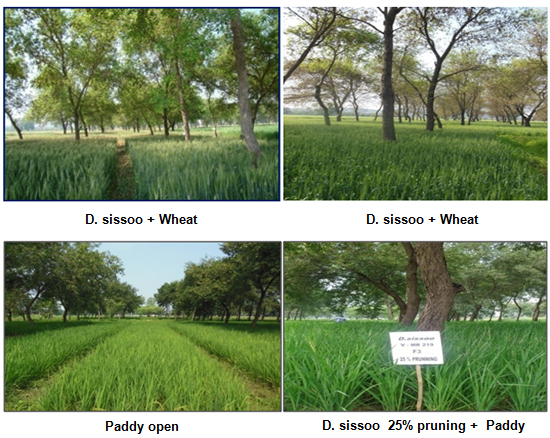
Estimation of genetic parameters of Acacia nilotica
- A specific breeding method (a two stage method of selection) has been identified for improving Babul trees.
- Significant correlations between first year (juvenile) and tenth year measurements in field have been obtained.
- Genetic variation in growth characters between provenances at the age of 5 years. The best provenance in terms of linear growth and volume was from Firojpur.
- The relative performance of individual provenance was fairly consistent through the years. The provenance heritabilities were found higher than single tree heritabilities. The heritabilities for height and volume were especially encouraging. The expected genetic gains were more obtained under two breeding system.
- The expected genetic gains are obtained under two breeding system.
| |
Provenance |
|
|
|
Single tree |
|
| Trait |
δg |
i |
h2 |
G |
δp |
i |
h2 |
G |
| Height (m) |
0.447 |
1.07 |
0.87 |
11.56 |
0.707 |
1060 |
0.645 |
26.09 |
| Dbh (cm) |
0.559 |
1.07 |
0.705 |
13.38 |
1.086 |
2.6 |
0.263 |
16.62 |
| Db (cm) |
0.693 |
1.07 |
0.814 |
11.83 |
1.311 |
2.6 |
0.287 |
15.2 |
| Cl. Vol. |
0.004 |
1.27 |
0.789 |
80.16 |
0.013 |
2.06 |
0.246 |
131.76 |
| (m3/tree) |
|
|
|
|
|
|
|
|
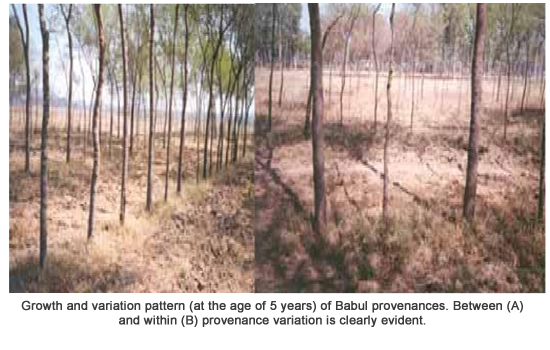
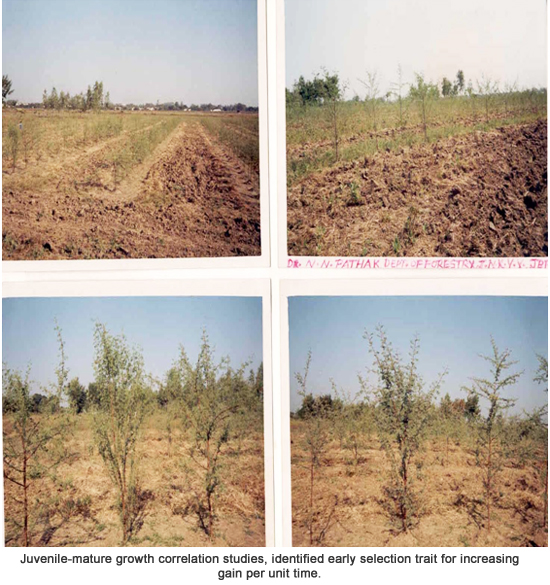
Genetic improvement Dalbergia sissoo (Roxb.)
Dalbergia sissoo (Roxb.) has multiple uses such as fuel wood, fodder, shade,small timber and nitrogen fixing ability. It is a salt tolerant, drought resistant and frost hardly too. Its wood is hard, heavy, strong and desirable. It is useful for stabilizing eroding sites and found in a variety of wastelands as a colonizing species. In addition, it can be grown under different systems like Agro forestry, social forestry and industrial / energy plantations. Impact of variable spacing on pattern of genetics variation and interrelationship among growth traits and yield was observed in Dalbergia sissoo.
The basal diameter, dbh, cylindrical volume, mean specific gravity, specific gravity at the bottom (0.30 m), dbh (1.37 m) and top of tree (4.00 m), and tree weight having maximum value in the spacing of 2 m x 2 m i.e. 9.18 cm, 9.06 cm, 0.050 m3, 0.785, 0.794, 0.795, 0.770 and 30.0 kg respectively indicated the suitability of 2 m x 2 m spacing i.e., 2500 tree /ha for better growth and yield.
Within tree variation of specific gravity at base i.e., old growth was more compared to top growth (juvenile growth). It showed increase in specific gravity with decreasing age of the tree is seen in a negative relationship between specific gravity and tree height.
The treatment effects were highly significant suggesting existence of high genetic variability in the population under study. Such variability is desirable and can be utilized for developing new genotypes in D. sissoo. This variability provides many avenues for genetic improvement in the Sissoo
High heritability with high genetic advance as per cent of mean was manifested by basal area; basal diameter and dbh revealed predominance of additive gene action and indicated strong genetic control of these variables.
Pooled analysis of growth traits from 2010-2013 showed significant years and spacing interaction for all growth traits except for tree height.
A correlation matrix of various growths attributes revealed strong and positive association among these attributes. The per unit increase in tree height, basal diameter, dbh, basal area and inter node length leads to increase the cylindrical volume production by 1.797, 1.802, 1.890, 3.742 and 2.356 respectively.
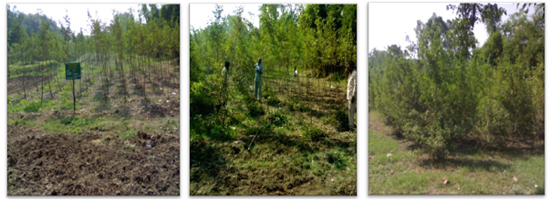
Genetic Improvement of Karanj
Pongamia pinnata (L.) Pierre (Karanj) is one of the fast growing leguminous treesthat has a high potential for oil seed production with the ability to grow on marginal lands which supports its cultivation as a potential biofuel crop for biodiesel industry.
High phenotypic and genotypic coefficient of variation was observed for seed yield, pod yield, and volume of seed suggested greater phenotypic and genotypic variability among the accessions and responsiveness of the attributes for making further improvement by selection. High heritability with high genetic advance as per cent of mean was observed for seed weight per tree, seed yield, pod weight per tree and pod yield which may be attributed to predominance of additive gene action.
The positive association of kernel oil content was observed with volume of seed followed by seed length, seed width, seed thickness, seed yield, pod yield and seed- pod ratio. The dependent character for kernel oil content was volume of seed, seed thickness, seed length, seed width, seed yield and pod yield.
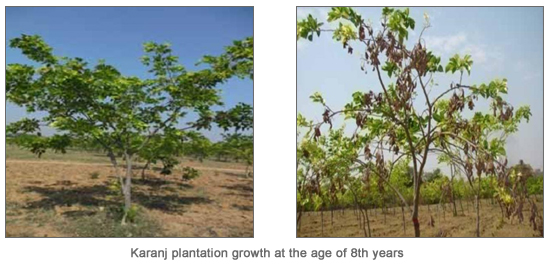
Seasonal incidence of Bruchus bilineatopygus on pods of Albizia lebbeck
Infestation was recorded, 42%, 31% and 53% during first third and last week of May, respectively No damage was observed on the pods collected during the month of Jan., Feb, March, and April. Colour gradation was also done. Maximum damage was observed in case of dark coloured seeds. Spraying of monocrotophos (20 ml 0.05%) on trees during September, October was found effective in controlling the pest.
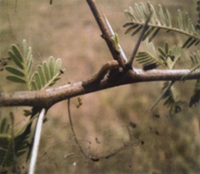 |
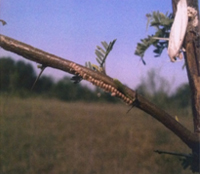 |
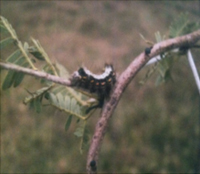 |
| Geometrid caterpillar |
Hairy caterpillar |
Lymantria insect |
Bacterial diseases of forest nurseries
Forest nurseries were found infected with bacterial diseases like bacterial wilt of Teak (Tectona grandis L.) caused by Pseudomonas tectonae, Angular leaf spot of Pipal (Ficus religiosa L.) caused by Xanthomonas campestris pv. Fici, Bacterial leaf spot and blight of Neem (Azadirachta indica) caused by Xanthomonas campestris pv. azadirach; Bacterial canker of Caronda (Carissa congesta) incited by Xanthomonas campestris pv. carissae, and bacterial leafspot of Mango ( Mangifera indica) caused by Xanthomonas campestris pv. Mangifera indica and bacterial wilt of Casuarina equisetifolia caused by Pseudomonas solanacearum.
10. Management of foliage diseases
Powdery mildew of Teak caused by Uncinula tectonae was effectively controlled by the use of sanitation practices i.e. burning of the defoliated leaves during summer followed by spraying of Karathane or Calixin 0.05% at 10 days interval testing immediately after the appearance of the first symptom. Search for resistance was made by screening 17 provenances from different places. However, none was found resistant.
- Light Trap Studies: Light trap studies of teak defoliator was conducted at dusty acre farm of JNKVV, Jabalpur using Pennsylvanian light trap with 160 vapour lamp. Day to day collection was made and their number was recorded. The above studies were made on the onset of monsoon. The appearance of this pest was initially recorded in June. However, maximum catch i.e. 2329 and 2109 was noted on 15th and 16th July respectively. It was conducted that maximum infestation of this pest normally occurred in July month.
- Selepa celtis Infestation on Acacia nilotica: The percentage infestation by Selepa celtis was low (2%) during third week of June. The plant infestation (average of two locations) gradually increased to maximum value (33%), during third week of August. Larval infestation ranged between 22.61 third week of June to 73.77% during third week of August. Larval population remained between 1.25 to 6.33%. The percentage infestation and larval population both were at their peak during August and September.
- Insect Pests Associated with Forest Saplings: During survey incidence of various insects on randomly selected eight tree species viz; Cieba pentandra, Emblica officinal is, Eucalyptus spp., Feronia elephantum, Sesbania grandiflora, Syzygium cummi, Tamarindus indica and Tectona grandis were recorded fortnightly. Most of the insects appeared in the month of August with a peak infestation period in September and October. The infestation caused by Leucinodes orbonalis and Ophiusa janata was confined to Emblica officinal is. Lepidoptera was the dominating order followed by Isoptera, Coleoptera and Hemiptera.
- Insect Pests Associated with wood: An experiment was initiated during January 2006 to study the effect of damage of wood borer Sinoxylone anale Lense in disc of seventeen year old Dalbergia sissoo. Maximum damage was recorded in disc on main trunk as compared to branch and sub branch. Damage was noticed on outer periphery of the disc (3 cm). No damage was recorded in the hard wood. The depth of damage hole was also maximum 4 cm deep in main trunk disc. 40 grams dust was recorded during the month of August, which also showed peak infestation period as compared to other damaging periods i.e. month April (11gm) and June (21) gram.
- Insect Pests Associated with forest seed: Studies on host preference of Bruchus bilineatopygus pic on stored forest seeds viz; Albzia lebbeck, Albizia procera and Sesbania grandiflora was carried out under laboratory condition. Maximum 66%, 58% and 6.8% seed damage was recorded in seeds of Albizia lebbeck, Albizia procera and Sesbania grandiflora. The development period i.e. number of days taken to develop from egg to adult was 41.6, 46.2 and 53 days on the seeds of Albzia lebbeck, and Albzia procera, Sesbania grandiflora, respectively. Maximum adult emergence was observed from seed of Albizia lebbeck Albzia procera. The seeds of Albizia lebbeck, and Albizia procera were categorized visually in to big and small seeds. Colour grading was also done. Maximum damage was observed in case of dark colour seeds.
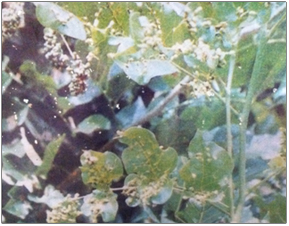 |
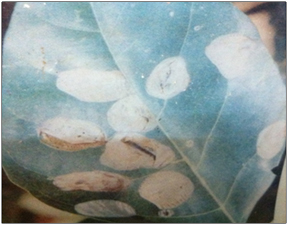 |
| Gall midge attack |
Leaf miner attack |